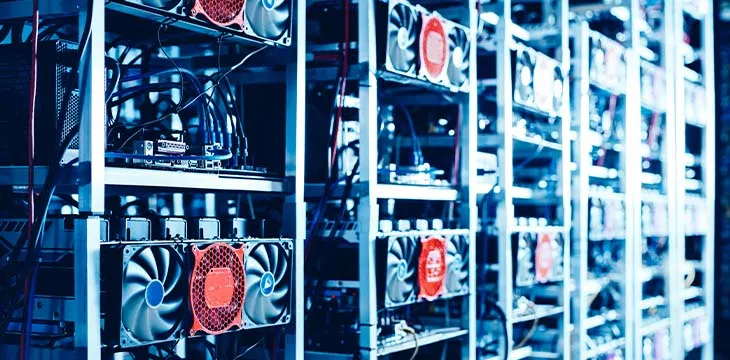|
Getting your Trinity Audio player ready...
|
The Biden administration has its eyes on the proof of work (PoW) mining industry. Costa Samaras, the principal assistant director for energy for the White House Office of Science and Technology Policy (OSTP), says that the White House is preparing to release a report on blockchain mining.
“It’s important if this is going to be part of our financial system in any meaningful way, that it’s developed responsibly and minimizes total emissions,” said Samaras.
“When we think about digital assets, it has to be a climate and energy conversation,” he added.
Forward guidance for blockchain
The report is expected to be published in August. It will allegedly explore issues around mining, such as the noise pollution mining rigs emit, the energy efficiency of different consensus mechanisms, and more.
“The growing global focus on Environmental, Social, and (Corporate) Governance, Climate goals and accords, as well as the rising price of energy, have incentivized policymakers to really begin understanding the economic and energy impact of blockchain technology,” said Bryan Daugherty the Public Policy Director for BSV Blockchain.
“Reports such as these greatly affect the industry across the board, from innovation to understanding. This is an opportunity to ensure continued leadership from the United States in terms of national security, innovation, and global equity if the committee is educated on the important differences in security between consensus models and the sustainable and scalable capabilities of a correctly implemented Proof of Work protocol.
“Due to the global leadership of the United States, if the report reflects a misunderstanding of the capabilities of a correctly implemented Proof of Work model and is broadly categorized as energy inefficient, the industry and the nation will suffer from increased national security critical infrastructure vulnerabilities and financial inequities and abuses the report sought to mitigate,” Daugherty explained.
The report that the Biden administration releases will significantly impact the blockchain and digital asset space. It will highlight the pros and cons of the industry, and it will hint at what the sector should look like in the future. Many companies operating in the industry will most likely adjust their business operations in preparation for that future.
Blockchain vs. Digital currency
Globally, governments are trying to reduce the amount of energy that proof-of-work mining consumes. Daugherty believes that this is because there is an education gap between industry players and lawmakers.
“Cryptocurrency and blockchain are not synonymous, nor are all Proof of Work blockchains the same, unfortunately for anyone exploring this industry, including lawmakers, it’s not plainly written on the door,” said Daugherty.
When most people think “blockchain,” they immediately think of the several coins and tokens available on exchanges like Binance and Coinbase (NASDAQ: COIN) that they can speculate on. But when looking at blockchain technology through the lens of the speculator, you miss out on the utility it can provide in business and consumer settings to reduce costs and boost profits while increasing transparency, security, and efficiency across operations.
“The “Crypto For Congress” website seeks to “raise awareness of and expand access to blockchain technology, while broadening participation in the political process” If one was to review their toolkit for Congress, there is no information regarding the utility of blockchain, rather it focuses on helping political proponents of cryptocurrency to accept campaign donations like Bitcoin (BTC). In my opinion, this sends the wrong message about the real utility blockchain provides,” said Daugherty.
“In comparison, a scaled Proof-of-Work blockchain such as Bitcoin (BSV) is significantly more sustainable (more than 1100 kg of Co2 per BTC Transaction vs. less than 2 kg of Co2 per BSV) and has already been competing with legacy technology energy consumption, vastly improving upon current energy utilization. For example, Certihash ‘Sentinel Node’, which is currently being developed by IBM and SmartLedger, helps mitigate the detection time of a network breach from the average 212 days to nearly instant. This type of blockchain-empowered utility can have a resounding effect on future information security data breaches but wouldn’t be possible without the security and stability that Proof-of-Work provides,” he revealed.
Daugherty believes that if more lawmakers, businesses, and consumers were aware that blockchain technologies could be used for more than speculating on the price of coins and tokens, the global sentiment around proof-of-work mining would be much more positively skewed than it is today.
“While it is extremely positive for cryptocurrency, blockchain, and energy consumption to be under the scope, I hope that policymakers will be able to overcome some of the immediate obstacles while attempting to navigate and understand all the various components of this technology,” said Daugherty.
“It is hoped that the report will reveal the differences between the consensus models, setting standards of efficiency based on transaction volume and throughput, as well as utilize existing legislation to cover digital assets, rather than creating new rules.
“On the other hand, it is also possible the United States will choose to increase regulation against Proof of Work consensus protocols, overlooking scalable implementations, and both stifling innovation and decreasing national critical security,” Daugherty added.
Watch: The BSV Global Blockchain Convention presentation, Sentinel Node: Blockchain Tools to Improve Cybersecurity
https://www.youtube.com/watch?v=gB1f_2cCF64

 09-13-2025
09-13-2025 





